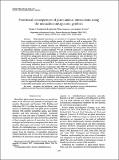Por favor, use este identificador para citar o enlazar a este item:
http://hdl.handle.net/10261/155659COMPARTIR / EXPORTAR:
 SHARE SHARE
 CORE
BASE CORE
BASE
|
|
| Visualizar otros formatos: MARC | Dublin Core | RDF | ORE | MODS | METS | DIDL | DATACITE | |

| Título: | Functional consequences of plant-animal interactions along the mutualism-antagonism gradient |
Autor: | Rodríguez-Rodríguez, María C. CSIC; Jordano, Pedro CSIC ORCID CVN ; Valido, Alfredo CSIC ORCID | Palabras clave: | Individual-based pollination networks Mutualist. Canary Islands Bird pollination Antagonist Interaction strength Isoplexis canariensis Mating network Female reproductive success |
Fecha de publicación: | 2017 | Editor: | Ecological Society of America | Citación: | Ecology 98: 1266- 1276 (2017) | Resumen: | Plant-animal interactions are pivotal for ecosystem functioning, and usually form complex networks involving multiple species of mutualists as well as antagonists. The costs and benefits of these interactions show a strong context-dependency directly related to individual variation in partner identity and differential strength. Yet understanding the context-dependency and functional consequences of mutualistic and antagonistic interactions on individuals remains a lasting challenge. We use a network approach to characterize the individual, plant-based pollination interaction networks of the Canarian Isoplexis canariensis (Plantaginaceae) with a mixed assemblage of vertebrate mutualists (birds and lizards) and invertebrate antagonists (florivores, nectar larcenists, and predispersal seed predators). We identify and quantify interaction typologies based on the sign (mutualistic vs. antagonistic) and strength (weak vs. strong) of animal-mediated pollination and test the relationship with individual female reproductive success (FRS). In addition, we document pollinator movement patterns among individual plants to infer events of pollen transfer/receipt that define the plant mating networks and test the relationship with FRS. We identify six interaction typologies along a mutualism-antagonism gradient, with two typologies being over-represented involving both mutualists and antagonists and influencing FRS. Plants showing strong mutualistic interactions, but also (weak or strong) interactions with antagonists are relatively better connected in the mating network (i.e., with higher potential to transfer or receive pollen). Thus, mixed flower visitor assemblages with mutualists and antagonists give plants increased their importance in the mating networks, promote outcrossing and increasing both female and male fitness. Our approach helps characterize plant-animal interaction typologies, the context-specificity of diversified mutualisms, and a better forecasting of their functional consequences. | URI: | http://hdl.handle.net/10261/155659 | DOI: | 10.1002/ecy.1756 | Identificadores: | doi: 10.1002/ecy.1756 issn: 0012-9658 |
| Aparece en las colecciones: | (EBD) Artículos |
Ficheros en este ítem:
| Fichero | Descripción | Tamaño | Formato | |
|---|---|---|---|---|
| Rodr-guez-Rodr-guez_et_al-2017-Ecology (1).pdf | 866,35 kB | Adobe PDF |  Visualizar/Abrir |
CORE Recommender
SCOPUSTM
Citations
31
checked on 11-abr-2024
WEB OF SCIENCETM
Citations
26
checked on 21-feb-2024
Page view(s)
304
checked on 23-abr-2024
Download(s)
631
checked on 23-abr-2024
Google ScholarTM
Check
Altmetric
Altmetric
NOTA: Los ítems de Digital.CSIC están protegidos por copyright, con todos los derechos reservados, a menos que se indique lo contrario.
